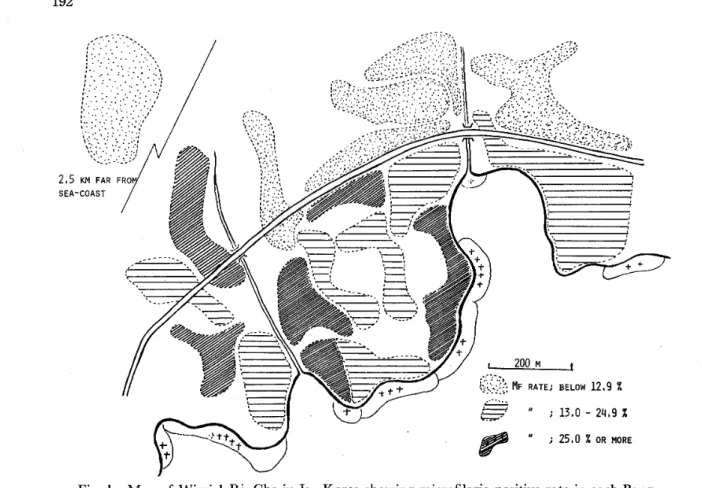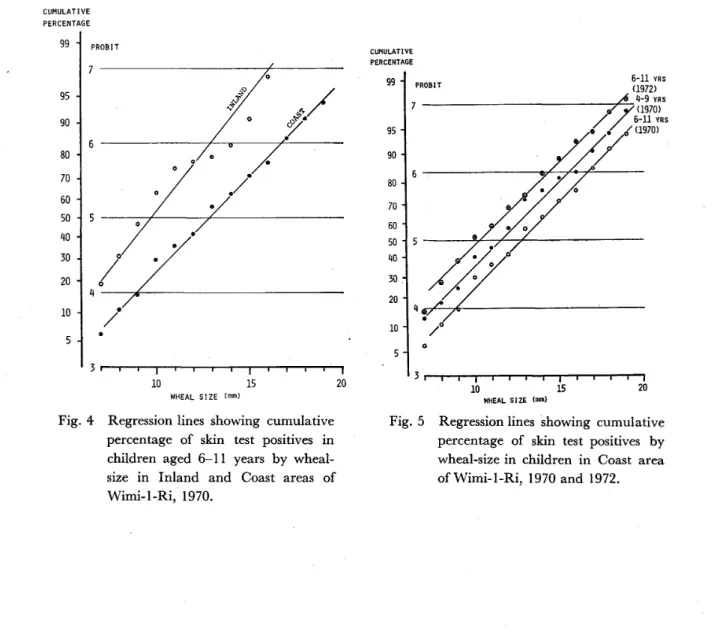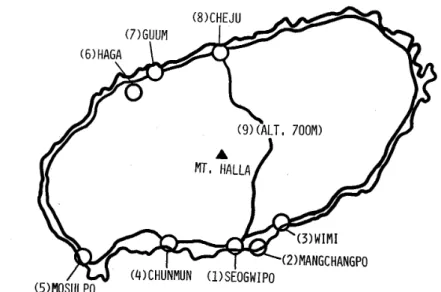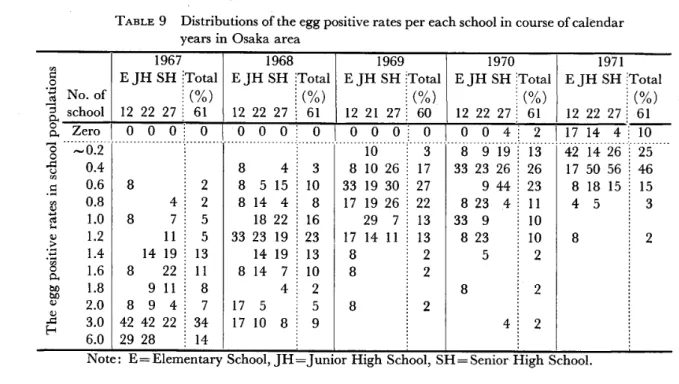第1巻 第3,4号 昭和48年12月20日
内 容
総 説
マラリアにおける薬剤耐性問題の現状
・中林 敏夫 177−188
原 著
韓国済州島のマレー糸状虫に関する研究
1流行地の皮内反応から見たマレー糸状虫症の疫学
・片峰 大助,佐藤 淳夫,多田 功,青木 克己 189−196 韓国済州島のマレー糸状虫に関する研究
2マレー糸状虫の伝搬蚊…………一一甲………和田 義人,片峰 大助・呉 文儒 197−210 インドネシアの好酸球増多症
一西部ジャワ・マジャレンカ山岳地帯の住民について一一…… 甲宮崎 吉平 211−224 マムシ咬傷のタンニン酸溶液洗條法による治療効果について
・岡本 憲司,中出、幸克,吉田 幸雄 225−229 学校検便成績よりみた腸管寄生虫感染の疫学的衰退過程の研究
・・石崎 達,森下 薫,鈴木 黎児,岡田 義治,藤井 正男,田島 功 231r243
日熱医会誌
Jap.J.T.M。H. 日 本熱帯医学会
日本熱帯医学会雑誌 第1巻 第3,4号 頁177−188 177
マラリアにおける薬剤耐性問題の現状
中 林 敏 昭和48年9月10日
夫付 受
は じ め に
1972年末の推定としてWHO資料(WHO,
1973)は,マラリア人口および分布について次の ように述べている。本来のマラリア分布地(中国 北朝鮮,北ベトナムを除く)における居住者約 18.4億中,マラリア撲滅を達成したか,その対策
が進行中の地域における住民数は約13.5億(73%)
に達している。しかし,・他の約4.9億(27%)の人 口は,何らの組織的なマラリア防圧対策を受けて いないか,ごく限られた範囲のマラリア対策の恩 恵に浴しているにすぎない。マラリアの地理的分 布を見ても,幾っかの小地域を除いてはその撲滅 達成への道はまだ遠いことがわかる(Fig・1)。
マラリア分布の種別特徴の1っに,濃厚な浸淫 地ほど熱帯熱発生の比率が高いことが知られてい る。少し古いが,1966〜7年度の資料(WHO,
1969)では,アフリカのザイール,エチオピァ,
ローデシア,タンザニア,ナイジェリア,リベリ アなどで全マラリア発生数中の熱帯熱の比率が 90%以上に達し,東南アジアでもタイ,ビルマ,南 ベトナム,インドネシア,マレーシア,フィリピ ンなどで熱帯熱が過半数を占めている。このよう な現状からして,治療及び防圧対策上もっとも重 要視されるのは熱帯熱と言える。
マラリア防圧対策の推進には多くの陰路がある。
それらの中で,薬剤治療や予防対策に直接影響す る重要課題の1っにマラリア原虫の薬剤耐性問題
㊥
︑湖総
難翻壇 翻購聯麟
鑑
聾郡鱒
マ
掛…1…癒凱☆盤1灘』d
(modined from the mapcited in WHO Chronicle,1972,vol.26,p.494)
Fig.l Malaria situation in the world onJune30,1971 長崎大学熱帯医学研究所 疫学部門
がある。筆者は過去何回か東アフリカ,東南アジ ア,ことにフィリヒ。ンのマラリア調査に従事した 経験があり,この機会にマラリアの薬剤耐法問題 の現況を簡単に要約,紹介することとしたい。
主な抗マラリア剤とその作用 数多い抗マラリア剤の中で,もっとも有効な治 療剤として使用されているのは chloroquine,
amodiaquineなどの4−aminoquinoline系薬剤で ある。最近では一連のサルファ剤中に顕著な抗マ ラリア作用を示すものが見出されっつあることは 興味深い。主な抗マラリア剤及びその主要な作用 を一括すると次表の如くである(TABLE1)。
これら多くの抗マラリア剤は,マラリア原虫の
発育環中のどの発育期に作用するかにより次のよ うに区別される。抗血中繁殖体剤(blood schizon−
tocide),通常,抗繁殖体剤(schizontocide)と言 えばこれを指す。 抗組織内繁殖体剤(tissue schizontocide)あるいは抗赤外型剤,これはさら
に抗第1次または抗第2次組織内繁殖体剤 (pri−
maryor secondary tissue schizontocide)に区分 される。これらの他に,血中の生殖母体を殺滅す る抗生殖母体剤(gametocytocide)及び患者に投 与すると,その患者を吸血した蚊体内でのマラリ
ア原虫の発育を阻害するスポロゾィト形成阻害剤
(sporontocide) がある。人体内に侵入したスポ ロゾィトを殺滅することにより,もっとも根源 的な予防効果を示すと思われる薬剤にっいては,
TABLE l Antimalarial drugs in general use and their main actions
Drugs Actions
1)
2)
3)
cinchona alkaloides(quinine,一)
4−aminoquinolines(chloroquine,amodiaquine,一)
pyrimidines(pyrimethamine,trimethoprim,一)
4) biguanides(proguanil,chlorproguanil,一)
5〉 acridines(mepacrine,CI423,一)
6)8−aminoquinolines(primaquine,pamaquine,Win5037,一)
7)
8)
sul飴nes and sul飼namides
diaphenylsulfbne(DDS,dapsone,一)
sulfbrmethoxine(sul魚doxine,Fanasi1,一)
sulfamethoxypyrazine(sulfalene,Policydal,一)
sul魚monomethoxine(Daimeton,一)
sul伍methoxypyridazine(Lederkyn,一)
sul肱dimethoxypyrimidine(sul魚dimethoxine,Sulxin,一)
sulfadiazine others
cycloguanil embonate*(Camolar,一)
diacetylaminodiphenylsulfbne**(acedapsone,DADDS,一)
hydroxynaphthalene(BW377−C−54,一)
blood sch並ontocide blood schizontocide blood schizontocide
primary tissue schizontocide blood schセontocide
primary tissue schizontocide sporontocide
blood schizontocide
primary and secondary tissue schizontocide,gametocytocide sporontocide
blood schizontocide
blood schizontocide blood schizontocide blood schizontocide
*and**: A mixture ofcycloguanil embonate and acedapsone is known as Dapolar
(modi且ed仕om WHO,1967ンand Peters,1970)
179 まだ何の知見も得られていない。もちろん,1薬
剤が2っ以上の作用を示すこともあり,また原虫 種により作用の強弱がある。
抗繁殖体剤は血中の無性型原虫(asexualform)
に作用する薬剤で,治療と発病抑制の両目的に多 用される。したがって,薬剤耐性問題の対象も必 然的に抗繁殖体剤に集中される。その意味でここ で話題としてとりあげる薬剤も 4・aminoquino−
lines,pyrimidines,acridines,sulfonamidesなど が中心となり,それに2,3の他系統のものが加 わってくる。
原虫の人体内発育と再発
マラリアの再発(relapse)と言われるものには,
臨床的および原虫学的の2っの意味が含まれるが,
要するにある期間を置いて病状が再出現または増 悪する,あるいは血中の無性型原虫が再出現する か増多することに裏付けられた現象である。ここ で言うある期間とは,マラリアの熱発作間隔を指 すのではなく,通常,患者が治癒したと見なされ
る状態になってからの期間を意味している。/
再発の起因には2っの解釈があり,その区別は 原虫の発育環と関連している。すなわち,第2次 赤外型を持たない熱帯熱と,それを持っ他種とで 解釈が異ってくると言うことである。1963年に WHO専問委員会は再発の概念を次のように統一 することを提案した。再発の1っは短期再発
(short−termrelapse)または再燃(recrudescence)
で,血中に残存する無性型原虫の増殖に由因する。
普通には先行する病状の治癒(無性型原虫症の消 失,正確には顕微鏡検査結果の陰転)後,2カ月 以内の再発に当る。 他は長期再発(long・term relapse)または再現あるいは再起(recurrence)
と呼ばれ,第2次赤外型より赤血球内に移行した 原虫の増殖,換言すれば,赤外型による赤血球の 新たな感染に由来するもので,通常,6カ月以上 の期間をおいた再発である。この解釈では,2な いし6カ月の間には再燃と再現の両者があること を暗に物語っている。要するにこの期間的な区分 は絶対的なものではなく,多くの経験から導き出.
された再発の由来を識別するための一応の目安と 受けとるべきものであろう。以上の内容を要約す
ると以下となる。
再 発 の 区 分 発現する原虫種 起 因
再 燃
再発/recrudescence
relapse\(2ヵ月以内)
再現または再起 recurrence (6カ月以上)
すべての原虫種
熱帯熱以外の原虫種
残存する血中無性型原 虫の増殖に由る
第2次赤外型による赤 血球の新感染に由来す
る
抗マラリア剤に対する原虫の耐性,すなわち感 受性の低下を認識するためには,一般的には十分 な治効量と見なされる薬量の投与に対し,無性型 原虫がその薬剤作用に抗しっっ生存,さらに増殖 することを観察しなけれぱならない。換言すれば 血中無性型原虫の再出現または増数,すなわち再 発の検出が耐性認識の手段となる。ただその場合,
主として血中無性型原虫に効力を発揮する抗繁殖 体剤に関しては,生残する血中無性型原虫の増殖 による再燃(recrudescence)のみが耐性如何の 判定に役立っのであって,赤外型に由来する再発,
すなわち再現(recurrence)は対象外とせねばな らない。この意味で,すべての再発が再燃と見な し得る熱帯熱にっいては,耐性問題をとりあげる ことは比較的容易なことと言える。これに反し,
再燃と再現の両者をもつ他種マラリアでは,慎重 な検討方法と判断によらねば結果を誤認すること になりかねない。健康ボランティアーへの血液接 種感染を行なって薬剤感受性を再検査する方法な どがよく用いられる。この場合には赤外型の存在 を無視しえるからである。
このようなわずらわしい方法や判断に頼らねば
ならない理由は,マラリア原虫が人体内で複雑な 発育環をもっていることの他に,原虫の試験管内 培養や実験動物感染がきわめて困難であることに よると思われる。しかし,最近では限られた条件 下での培養やnightmonkeyなどへの感染実験が 成功しているので,今後の応用が期待される。
薬剤耐性の検討に当って重要なことの1っに再 感染がある。浸淫地における検査では,観察下の 患者が常に伝播蚊による新しい感染の機会に曝露 されていると言ってよい。かかる条件下では再発 と再感染の鑑別が不可能な場合が多い。故に浸淫 地における耐性の検査においては,再感染を完全 に否定しえる条件を作る必要が生じてくる。これ がいかに困難なことであるかは,実際に事に当っ て,まず遭遇する最初の問題である。
野外調査における薬剤耐性の検査法 何回もの変遷を経た後,WHO専門委員会
(WHO,1968)は,マラ・リア浸淫地の野外調査にお ける熱帯熱原虫のchloroquine(以後CQ)感受性 試験方法の規準を次のように定めた(TABLE2)。
CQ25mg/kgを3日間に分割投与する用量は 標準治効量と見なされている。ここで言う投与量
とはCQ塩基量であって,燐酸塩量または硫酸 塩量ではない。以下の記載もすべてCQ塩基量で 示してあることに留意されたい。表中に示された 各日毎の CQ投与量については,検査者により 幾分相異することが少なくない。むしろ先に Cove118厩乙(1955),WHO(1967)が推薦した投
与法,すなわち初日(Day O)1回目10mg/kg,6 時間後2回目5mg/kg,第2日(Day1)及び第3 日(Day2)おのおの5mg/kg一が採用されることが 多い。原虫検出のための検血は,DayOのCQ投 与前及び以後Day7までは毎日1回,その後 Day28までは毎週2〜3回の割で実施するよう 定めている。
この野外検査においては,結果の誤認を避ける ため,対象患者の選択と人数を考慮するよう望ま れている。少なくとも30人以上の対象者を選ぶこ とを1っの方針とし,また,浸淫地では血中原虫 数の少ない,いわゆるsemi4mmuneasymptoma−
tic carrierを対象とした場合には,本来の薬剤効 果を推定することができないことを警告している。
その他,実施に当っての注意事項として次の事 があげられている。1) 嘔吐,特に薬剤投与直後 に嘔吐を示す患者は除外する。2)重症患者あるい はきわめて原虫数の多い者は対象外とする。また 逆に,原虫数の余りにも少ないものは除外するか,
その増加を待ってCQ投与を始める。3)マラリア の混合感染者は以後の原虫種同定や原虫数の算定 に混乱を招くことがあり,除外する方がよい。4)
尿中CQ量の測定を行なうことが好ましい。5)で きるだけ正確に原虫数の算出を行なうべきである。
熱帯熱において,CQ標準量投与後の無性型原 虫血症(asexualparasitaemia)の消長から,その 原虫種のCQ感受性を判断する基準としてFig.2 に示すような解釈が与えられている(WHO,1967,
1968)。
Table2 A field test fbr strain sensitivity ofPJα鋤o伽7η声」 吻1π規to a standard regimen of chloroquine
CQ CQ CQ
10mg10mg 5mg…Total25mg CQ base/kg(159/60kg)
kg kg kg
Day o 1 2 3 4 5 6
黛1〃!
Parasite examination
Urine test for C Q
Note: Chloroquine is abbreviated to CQ.
7 8 9 10 26 27 28
Parasite exmination
2to3times weekly
(modiHed仕om WHO,1968)
181
衷目O帽君のO﹄吋O 建ミ剣魯起奥.飢 冨口図①の<
Sensitivity(S)
*
RI resistance,
delayed recrudescence
*
RI resistance,
early recrudescence
*
RII resistance
*
II「es §兜聾一一一、一
*
024 7 14 28
Days after start of treatmet on Day O *:Patency level
**:Chloroquine administered during first3 days Note:The broken line in the bottom diagram inidcated the posible increase in par−
asitaemia in the case ofRIIl resistance.
Fig.2 Response to field test fbr sensitivity offゑlciparum malaria to cholroquine**
(quoted貸om WHO,1968)
RII耐性とは原虫数の著明な減少があるものの,
消失することなく,増加に転じる場合に当るが,
この現象に関し,Harinasuta(1973)は最高血中
原虫数の25%以下の減少を見た場合をRII,それ 以上の数を維持した場合をRIIIとして区別する
ことを提案した。また,原虫血症の消失とは,少 なくとも連続2日間の検血で無性型原虫が陰性で あることを意味している。
なお,ここで言う野外検査とは,マラリア浸淫 地においては,たとえ対象患者を医療施設などに 収容した場合でも該当するもので,観察期間中の 再感染防止などには万全の措置を講じなけれぱな
らないのは当然である。
以上の方法とは別に高浸淫地における野外検査 法として,CQ10mg/kg,1回投与,翌日から毎
日7日間の検血で結果を判定する方法がある。こ の方法は1度に多数の患者を短期間内に処理しえ るので,前記の標準量投与法の検査対象を選択す るためのスクリーニングに用いられる(Ramosε孟
αム,1971)。
初〃i 御における熱帯熱原虫の薬剤感受
性検査(Riθ漉形4π 5 θ紛
Rieckman窃認(1968)は試験管内でCQと熱 帯熱患者血液とを38〜40。Cに24時間接触させ,
この間の輪状体より成熟繁殖体に至る原虫の発育 度を比較判定し,その熱帯熱原虫株のCQ感受 性を決定する方法を提出した。この方法は,普通
TABLE3 Standard oral−dosage ofantimalarials fbr acute malaria in adult
Dosage(mg)and days
Drug 1 2 3 4 5 6 7
chloroquine base 600十300 amodiaquine base 600 mepacrine dihydro− 200×5 chloride dihydratc
quinine salt* 2,000
proguanil
monohydrochloride pyrimethamine primaquine base
300 400 300
2,000
300 400 300
2,000 0r
1,300
100−3001day丘)r7to10days
300
2,000 0r l.300
50−100, same or reduced dose daily 151day for l4days
300
2,000 0r 1,300
300
2,000 0r 1,300
300
2,000 0r
1,300
*:Quinine in divided doses
(quoted貨om Covell蜘乙,1955;Manson−Bahr,1961;and WHO,1967)
には,末梢血液中に輪状体のみしか出現しない熱 帯熱原虫の特性をうまく捕えたものとして評価さ れる。以後,他の抗マラリア剤についても試みら れ,また,諸変法も報告されている。それらの詳 細は省略するが,この動∂伽o法が一般に生活環 境が悪く,実験設備の乏しいマラリア浸淫地で,は たして実用に供しえるかは今後の間題であろう。
感受性検査のための標準薬剤投与量 CQ以外の薬剤にっいて,マラリア原虫の感受 性を検査するために用いられる標準量をあげると Table3の如くである。この投与量は患者に対す る標準的治効量である。ただし,これらは各薬剤 の単独使用時の経口的投与量で,感受性検査の目 的に他剤との併用使用は避ける方が好ましいこと は言うまでもない。
サルファ剤の投与量は現在までのところ報告者 により相異し,また他剤との併用治療例が多いの で,ここに明記することはできないが,筆者らの経 験や文献的考察から,成人量はsulfamethoxypy−
razineでは初日800mg,以後200mg/日,6日間,
sulformethoxine及びsulfamonomethoxineでは
初日2,000〜4,000mg,以後1,000〜2,000mg/日,
3日間などが妥当な用量と思われる。
抗マラリア剤に対する耐性マラリアの分 布
現在までに確認された薬剤耐性マラリアについ て,熱帯熱を主としてその地域的分布を紹介する。
1.4−aminoquinoline系薬剤(CQ,amodiaquine など)に対する耐性熱帯熱の分布
現在までに確認されている4−aminoquinolines
(以下4AQ)に対する耐性マラリアは熱帯熱原虫 に限られている。しかし,4AQがマラリア治療 及び予防にもっとも多用されていること,熱帯熱 が臨床的,疫学的に最重要であることから,耐性 問題にっいても4AQ耐性熱帯熱が最大の関心を
持たれている。
a) 東南アジアにおける 4AQ耐性熱帯熱の 分布
東南アジア地域での最初の報告は,1962年の Harinasutaらによるタィ中央部及び南部におけ る9例のCQ耐性熱帯熱に関するもので,1965年 に詳報が出されている。以後,タイでは北部
(Cadiganε孟凪,1968),マレーシァ国境地方
(Bourke,1966),バンコック周辺(Clyde窃α乙,
1969)などに4AQ耐性が確認されている。
マレーシアでは1963年来,北部タイ国境地方
(Montgomery and Eyles,1963;Sandosham,
1965),南部ジョホール州などの地域(McKelvey θ雄乙,1968;Andreθ孟磁,1972)に診いても確認さ れた。ボルネオ島,サバーのBeau∫ortでClyde θ麺1.(1973)はCQ耐性熱帯熱を患者及びボラン
ティアーによって証明した。
カンボジアでも1960年代にCQ耐性が確認さ
れた(Eylesθ孟αム,1963)。この国ではpyrime−
thamine加食塩の常用を広範囲に実施した結果,
その耐性発現が警告されCQ加食塩に切り代えた いきさつがある。その後に東部及び中西部にCQ 耐性が認められた。
南ベトナムでは長期の戦乱中,全国土にマラリ アが蔓延し大発生したことは想像に難くない。
Powell8孟磁(1964)以来,主として米国研究者 によるCQ耐性熱帯熱の報告は多く,また多数の 耐性株が分離され,他剤との交叉耐性一(crOSS・
resistance)についても詳しく検査された。南ベ トナムで発生した4AQ耐性熱帯熱が隣接諸国の みならず,グアム,米本土にまで移入されたこと は注目すべき事である。
ラオスに関しては,1968年にフィリピンで amodiaquine耐性熱帯熱と判定された患者がラ オスで感染したものであった(WHO,1968;Shute 寵αム,1972)。海老沢ら(1970)はメコン河上流 のナムグムでCQ耐性熱帯熱の5例(内4名は
日本人)を報告した。
インドネシア領スマトラ島のPakanbaruでRI 型CQ耐性熱帯熱が検出されたと言う(Peters monograph,p.474,1970)。またシンガポールでは Ngε孟αム(1969),Paul and Colboume(1971)は
Palau Tekong島でCQ耐性熱帯熱を,ビルマ ではClyde8孟磁(1972,1973)がラングーン北方
183 でRII,RIII型CQ耐性熱帯熱の存在を確認した。
フィリピンでも1967,8年頃より4AQ耐性熱帯 熱の存在が疑われてきたが,具体的にはClydeε孟 紘(1971)がマニラ北方Montalbanの1患者よ
りCQ耐性株(Per stra1n)を分離したことに始ま る。Shuteθ∫αム(1972)は6例のamodiaquine 耐性熱帯熱を報告した。これらの患者中には南部 のPalawan島お・よびPanay島のAklanからの
2名が混じていた。Ramos8孟α1.(1971)は Palawan島のIwahig Penal Colony(イワヒグ 囚人部落)で自然感染及び血液接種熱帯熱患者中,
RI,RII型CQ耐性を検出し,さらにこれらが amodiaquine耐性であることを報告した。
筆者らも1969年来,Palawan島の同じ囚人部落 でCQ耐性熱帯熱の有無を検討し,前記の標準 投与量(CQ塩基25mg/kg)による治療法で多数 のRI及びRII型再燃例を観察した。その成績 は既に報告した(Nakabayashiα磁,1974)が,
結論的にはPalawan島のこの地域にCQ耐性熱 帯熱が分布することは,もはや疑の余地がないも のと考えられる。
b) 中南米における4AQ耐性熱帯熱の分布 Moor and Lanier(1961)の報告がCQ耐性熱 帯熱マラリアに関する世界最初のものとされてい
る。この感染は1959年にコロンビアで受けたもの で,後日この原虫種はamodiaquine耐性である
ことも判明した。以後,その分布はブラジル,コ ロンビア,ベネズエラ,ガイアナ,パナマに及び,
疑わしい地域としてボリビア,パラグワイ両国の ブラジルに隣接する地方があげられている。ブラ ジルではアマゾン川流域にその分布地が散在して いる。ガイアナではDDT撒布とCQ加食塩の常 用により一旦マラリアは激減したが,1962年に熱 帯熱がにわかに増加した。これは隣接するブラジ ルよりのCQ耐性熱帯熱の移入に由因すると言
われている(Giglioli瀦α乙,1967)。
1972年には中米のパナマでCQ及びamodia−
quine耐性熱帯熱の存在が確認された (Young and Johnson,1972;Johnson and Young,1972)。
これらの報告では,最初の疑わしい患者は1969年 に検出されたと言う。パナマの耐性株がパナマ土
着の原虫株に由来するか,コロンビアよりの移入 によるかは定かでないが,後者の考が強いようで
ある。
c) アフリカにおける4AQ耐性について 結論的には,現在までアフリカでは4AQ耐性
マラリアの確認はまだ無い。CQ耐性あるいは低 感受性熱帯熱として報告された地域は18ヶ国に 及ぶが,その後の再検討や野外調査の結果,いず れも耐性が確認されるには至らなかった(Bruce・
Chwatt,1970,1971;WHO,1967)。
何故アフリカで4AQ耐性が検出されないかの 理由は判然としない。4AQの使用が他の地域よ り少ないとも言われるが,マダガスカルのように 長年月CQ加食塩が常用された所もある。したが って,今後の検討に当っては,現在の観点に立っ て,慎重かつ念の入った方法で耐性の有無如何を 結論づけるべきであろう。
d)4AQと他剤との交叉耐性(cross−resistance)
地域により,また報告者により成績は異なるが,
簡単に要約すると,タイ,マレーシア,カンボジ アからはmepacrine,proguanilあるいはpyri−
methamineとの交叉耐性熱帯熱が,南ベトナムか らは以上の他にacridine系のCI423(後述),タ ィからはhydroxynaphthalene系のBW377−G54,
(後述)との交叉が報告された。また一般にCQ耐 性株はprimaquine常用量(15mg塩基/日)に耐 性を示すことが多いと言われる。マレーシアなど でCQ耐性熱帯熱が1部のサルファ剤に感受性が 乏しいと言う報告がなされている。
2. pyrimidine系薬剤(pyrimethamine,trime・
thoprimなど)に対する耐性マラリアの分布 pyrimethamine(以後PM)に対する耐性は,
主として熱帯熱に,1部地域で三日熱,四日熱に 認められている。PMは耐性を誘発する性質を 持つと言われていることは注目すべきである。
PM耐性熱帯熱の分布は世界的で,アジアでは 1953年来,インド,マレーシア,パキスタン,イ
ンドネシア(西イリアン),タイ・南ベトナム,カ ンボジアで,アフリカでは1951〜4年間にタンザ ニア,ケニア,スーダン,ナイジェリア,ザイー ル,ガーナ,リベリア,セネガル,ガンビアで多
くの報告がされた。ケニア,タンザニアでは広範 囲にPMの集団予防内服が試みられたが,その 後にPM耐性が各地に検出された。興味あること はPM投与を中止して後,耐性の出現が減少した ことから,Bray(1955)はPM耐性は不安定なも ので真の耐性か否か再吟味の必要があると論じた ことである。南米ではブラジル,コロンビア,ベ ネズエラから耐性熱帯熱が検出された。
ブラジル,パキスタンからは三日熱,ヶニアか らは三日熱,四日熱の耐性が報告されている。
PMはCQ,proguani1,cycloguanil embonate あるいは mepacrineとの交叉耐性として検出さ れることが多く,ことにproguanilとの交叉を示 す地域が少なくない。
3.biguanide系薬剤(proguani1など)および その類系薬剤に対する耐性マラリアの分布 proguani1(以後PG)に代表されるbiguanide 系薬剤は耐性を誘発すると言われている。現在・
熱帯熱の他に三日熱,四日熱に耐性が認められて いるが,PG耐性にっいてはPGを長期間使用し たことからか,PMとの交叉耐性の形かのいずれ かに由因して発現することが多い。
東南アジア各国,インド,パキスタン,アフリ カ各地,ブラジルなどでは熱帯熱の,オーストラ リア(ニューブリテン島),マレーシアでは三日熱,
四日熱,パキスタンでは三日熱のPG耐性が報告 された。また,タイ,南ベトナム,マレーシア,
ブラジルなどでは他剤との交叉耐性が少なくない と言われる。
貯留性 (repository) 抗マラリア剤である cycloguanilembonateについては,西アフリカ諸 国,タンザニアなどで検討されたが,セネガルで は期待通りの長期予防効果が得られなかったのみ ならず,PMあるいはPGとの交叉耐性の懸念が
示された。
4.その他の抗マラリア剤に対する耐性マラリア の分布
a) quinine
古くから使用されたキニーネに関しては,意外 に耐性についての報告が少ない。現在までにブラ ジル,タイ,マレーシアから耐性熱帯熱の報告があ
る。ブラジル北西部はキニーネの原木(cinchona tree)の原産地で,この地域では古くから長期間
マラリア治療に用いられっづけたことが,耐性原 虫発現と因果関係を持っとの考(Wemer,1911)
も見られるが,その真疑の程は分らない。南米で は三日熱の耐性も検出されている。
b) acridine系薬剤(mepacrine,CI423など)
mepacrineは勝れた抗繁殖体剤で第2次大戦中 に米,豪軍で使用され・卓越した効果を発揮した.
耐性熱帯熱については,終戦後ニューギニアの豪 軍中で検出されたのが最初である。このようなこ とからか,耐性は東南アジア各地で多く認められ,
ほとんどの場合,CQとの交叉耐性として認知さ れている。熱帯熱以外の原虫種にっいては,現在 まで耐性に関する具体的確認はない。
CI 423: 3−chloro−9一(4−diethylamino−1 一 methylbutylamino)acridine−10−oxideに対して
は,ブラジルで耐性熱帯熱が報告された。
c)8−aminoquinoline 系薬剤 (primaquine,
pamaquineなど)
本系薬剤は抗繁殖体剤としての効力は4AQな
どに比しはるかに劣るが,赤外型(組織内繁殖体)
に対する作用が顕著である。マラリアの治療,予 防には,CQなどと併用されるのが普通であり,
本系薬剤が単独でその耐性が云々されることは少 ない。耐性の検討に際しては,これでま述べた薬 剤と異なり,再燃の有無による判断の他に,赤外 型原虫の本剤に対する感受性にっいて,長期再発
(再現)を指針として耐性如何を検討せねばなら
ない。
primaquineにっいては1959年,ニューギニア で耐性三日熱(Chess・n株)が検出され,Am・1d 窃αム(1961)によると本株感染者にかなり大量 のprimaquineを長期間連日投与を行なったにも かかわらず,無性型原虫血症は消失しなかったと 言う。タイ,マレーシア,南ベトナム,ブラジル,
コロンビアなどでは耐性熱帯熱の存在が懸念され ている。なお,これらの場合,多くはCQとの交 叉耐性が問題となっている。
また,タイではWin5037:6−methoxy−8一(5 一 propylaminoamylamino)quinolineに対する耐性
185 熱帯熱の存在が疑われている。
d)hydroxynaphthalene系薬剤(BW377−C−
54など)
抗繁殖体剤として治療効果の知られた BW
377−C−54: 1,6−dihydroxy−2, 5−bis(cyclohexyl−
aminomethy1)naphthaleneに対し,ローデシア・
タィ,マレーシア,南ベトナム,コロンビアから 耐性熱帯熱が検出された。これらの大部分はCQ
と交叉耐性をを示している。
e) サルファ剤(sulfones及ぴsulfonamides)
近年マラリア治療に賞用されるサルファ剤にっ いては,まだ具体的な耐性株検出の報告は乏しい。
しかしサルファ剤には各種細菌類が比較的容易に 耐性化すること,また,実験マラリアにおいては すでに耐性株が得られていること(Peters,1970)
などから,早晩,耐性問題が提起されるものと考 えてよい。この点に関し,すでに少なからぬ警告 が発せられている(Bruce−Chwatt,1967;WHO,
1967)。
サルファ剤は一般に抗細菌剤として世界中で多 用されているため,どこかで忽然と耐性マラリア が検出されるようなことが起りかねない。また,
他剤との交叉耐性の懸念も大きい。特にその作用 機序は異なるとしても,同じ葉酸代謝阻害剤とし て知られるPMあるいはPGとの交叉耐性には十 分留意せねばならない。この点,ブラジルのGoiゑs 州でsulfadoxine(sulformethoxine)一pyrimeth・
amineまたはsulfamethoxazole−trimethoprimの 併用治療に対し,耐性を示したと思われる症例が 報告されている(Almeida Netto窃磁,1973)のは 注目すべきことであろう。
マラリアの治療,予防のための使用には,サル ファ剤の置かれる諸般の事情からして,その単独 使用を避けることが好ましい。また,僻地など医
療設備が乏しく専門家の監視がゆきとどかぬ所で は,長期間使用,あるいは大量投与を控えるべき である。これらの意味では,現在,諸持続性サル ファ剤とPMあるいはtrmethoprimなどとの併 用効果が強調されているのは当を得たことと思わ
れる。
お わ り に
以上でCQをはじめとする主な抗マラリア剤に ついて,耐性マラリア分布の現状と,それに先立 って,これら抗マラリア剤に対する原虫の感受性 検討に関する原則的な知識と方法にっいて解説し
た。
現在,すでに主要マラリア治療剤に対する耐性 問題は,ほとんどマラリア浸淫の全地域に及び・
防圧対策や患者治療に少なからぬ影響を与えっっ
ある。
こうした中で,新しい各種の抗マラリア剤が次 々と開発され,実用に供せられっっあることは喜 ぱしい限りである。また,実験マラリアによる薬 剤耐性の解析から,すすんで耐性化抑制剤の出現 を期待する声などもある。これらにっいての詳細 は省くが,最後に,今後マラリアの防圧,予防・
治療にたずさわる場合には,常に耐性問題を念頭 に置きっっ,薬剤の選択や用法,あるいは併用効 果の利用などに十分な考慮を払うことを強調した い。その意味で,この総説が少しでも役立っこと を得れぱ幸である。
本論文の要旨は昭和47年11月27日,第14回日本 熱帯医学会総会(長崎)における特別講演として 発表した。内容の1部は,その後の知見にしたが
って訂正または補足された。
文 献
1) Almeida Netto,J.c、,oliveiraンG・s・c・and sampaio,J・A・A・(1972〉:Resist6ncia do P伽一 ,ηo伽規漁」6吻彫窺ムassociagao sul飯midicos−antifblicos na regiao centro−oeste do Brasil,Dados refもrentes ao estudo de lO4casos,Revta Pathol.Trop、,1(3),385−393. Quoted in Trop.Dis.
BulL, (1973),70(9),834
2) Andre,P.G.,cadigan,E c、Jr.and Frederick,HJ・(1972):1n吻o and伽∂伽o studies of chloroquine−resistant malariain west Malaysia,Trans.Roy、Soc。Trop.Med.Hyg.,66(4),644.
652
3) Arnold, J. D., ',Alving A. S. and Clayman, C. B. ( 1961): Induced primaquine resistance in vivax malaria, Trans. Roy. Soc. Trop. Med. Hyg., 55 (4), 345‑350
4) Bourke, A. T. C., Puhomchareon, S., Cadigan, F. C., Gould, D.J. and Pinswasdi, K. (1966) : Prevalence of malaria exhibiting reduced sensitivity to chloroquine in southern Thailand, Trans, Roy. Soc. Trop. Med. Hyg., 60 (2), 225‑230
5) Bray, R. S. ( 1955) : Resistance of Plasmodiumfalciparum to primaquine, Trans. Roy. Spc. Trop.
Med. Hyg., 49 (1), 93‑94
6) Bruce‑Chwatt, L.J. ( 1970) : Resistance of P. falciparum to chloroquine in Africa : True or false? Trans. Roy. Soc. Trop. Med. Hyg., 64 (5), 776‑784
7) Bruce‑Chwatt, L.J. and Robert, J. M. D. ( 1972) : Dissent on the alleged finding of chloro‑
quine resistance in East Africa, Trans. Roy. Soc. Trop. Med. Hyg., 66 (2), 377‑378
8) Cadigan, F. C.Jr., Sadudee, N., Bourke, A. T. C., Gould, D.J. and Winter, P. E. (1968) : Survey on chloroquine‑resistant P. falciparum in Thailand, Trans. Roy. Soc. Trop. Med. Hyg.;
62 (4), 562‑566
9) Clyde, D. F. ( 1962) : History of the medical service of Tanganyika, Government Press, Dar es Salaam
lO) Clyde, D. F., Dawkins, A. T. Jr., Heiner, G. G., McCarthy, V. C. and Hornick, R. B. (1969) : Characteristics of four new drug‑resistant strains of Plasmodium falciparum from South‑East Asia, Exptl. Malaria, Military Med., 134 (lO), Special issue, 787‑794
l l) Clyde, D. F., McCarthy, V. C.) DuPont, H. L. and Hornick, R. B. ( 1973) : Characterization ofa drug resistant strain of Plasmodiumfalciparum from Burma, J. Trop. Med. Hyg., 76 (3), 5 i60 12) Clyde, D. F., McCarthy, V. C., Gilman, R. H. and Miller, R. M. (1973) : Characterisation of a drug resistant strain of Plasmodium falciparum from Sabah, J. Trop. Med. Hyg., 76 (9), 226‑230
13) Clyde, D. F., Han, C. M. and Huang, Y. S. ( 1973) : Resistance to chloroquine of Plasmodium falciparum from Sabah, Trans. Roy. Soc. Trop. Med. Hyg., 67 ( l), 146
14) Clyde, D. F.. Hlaing, N. and Tin, F. ( 1972) : Resistance to chloroquine of Plasmodiumfalciparum from Burma; Trans. Roy. Soc. Trop. Med. Hyg., 66 (2), 369‑370
15) Clyde, D. F. and Shute, G. T. ( 1954) : Resistance of East African varieties of Plasmodium fal‑
ciparum to pyrimethamine, Trans. Roy. Soc. Trop. Med. Hyg., 48 (6), 495‑500
16) Clyde, D. F., Shute, G. T., McCarthy, V. C. and Sangalang, R. P. ( 1971) : Characterization of a drug resistant strain ofPlasmodium falciparum from the Philippines, J. Trop. Med. Hyg., 74 (5), 101‑132
17) Covell, G., Coatney, G. R., Field, J. W. and Singh, J. ( 1955) : Chemotherapy of malaria,
69‑98, WHO, Geneva
18) Ebisawa, I., Muto, T., Kameko, S. and Mitsui, G. (1970) : Response of Laotian malaria strains to chemotherapy, Jap. J. Exptl. Med., 40 (3), 151‑157
19) Eyles, D. E., Hoo, C. C., Warren, McW. and Sandosham, A. A. (1963) : Plasmodium falciparum resistant to chloroquine in Cambodia, Amer. J. Trop. Med. Hyg., 12 (6), 840‑843
20) Giglioli, G., Rutton, F!J. and Ramijattan, S. ( 1967): Interruption of malaria transmission by chloroquine‑salt in Guyana, with observation on a chloroquine‑resistant strain of Plasmodium falciparum, Bull. Wld Hlth Org., 36 (2), 283‑301
2 l) Harinasuta, T. ( 1973) : Problems on chemotherapy of parasitic and enteric infections : Pro‑
tozoan infections, 12th Southeast Asian Region. Seminar Trop. Med. Publ. Hlth & 4th Seminar Trop. Med., May‑June, Seoul, Korea
22) Harinasuta, T., Suntharasamai, P. and Viravan, C. ( 1965) : Chloroquine‑resistant falciparum malaria in Thailand. Lancet, ii (7414), 657‑660
23) Johnson. C. M. and Young, M. D. ( 1972): Response of drug‑resistant Plasmodium falciparum
187 to combined therapy in Panama, J. Trop. Med. Hyg., 75 (7), 133‑135
24) Manson‑Bahr, P. H. ( 1961) : Manson's tropical diseases, 15th edit., Cassell & Co. Ltd., London 25) McKelvey, T. P. H., Lundie, A. R. T., Williams, E. D. H., Moore, H. S. and Worsley, D. E.
( 1968) : Chloroquine‑resistant malaria in west Malaysia, Brit. Med. J., 4 (5632), 703‑704 26) Montgomery, R. and Eyles, D. E. ( 1963) : Chloroquine resistant falciparum malaria in Malaya,
Trans. Roy. Soc. Trop. Med. Hyg., 57 (6), 409‑416
27) Moore, D. W. and Lanier, J. E. ( 1961) : Observation on two Plasmodium falciparum infections with an abnormal response to chloroquine, Amer. J. Trop. Med. Hy ., 10 (1), 5‑9
28) Muto, T., Ebisawa, I. and Mitsui, G. ( 1971) : Malaria at the Nam Ngum Dam construction site in Laos (therapeutic effect of combined folic inhibitor and other drugs), Nettai, 5 (4), 204‑2 13 29) Nakabayashi, T., Tsukamoto, M., Miyata, A., Tsuneda, K., Yamaguchi, K., Miyagi, I., Dulay, I. S. Jr. and Puriran, J. A. ( 1974) : Chloroquine‑resistant Plasmodium falciparum in the lwahig area of Palawan Island, the Philippines, Trop. Med., 16 ( I ), 1‑lO
30) Ng, W. C., Fung, W. P., Colbourne, M.J. and Gills, H. M. ( 1969) : Chloroquine‑resistant malaria in Singapore, Ann. Trop. Med. Parasitol., 63 (3), 3 13‑3 16
3 1 ) Paul, F. M. and Colbourne, M.J. ( 1971) : Chloroquine resistant malaria in children from a Chinese albino family in Palau Teckong, Singapore Med. J., 12 (3), 147‑153
32) Peters, W. ( 1969) : Drug resistance in malaria ‑ A prospective, Trans. Roy. Soc. Trop. Med.
Hyg., 63 (1), 25J}O
33) Peters, W. (1970) : Chemotherapy and drug resistance in malaria, Academic Press, London and New York
34) Powell, R. D. (1965) : The effect of 6‑methoxy‑8‑5‑(5'‑propylaminoamylamino)‑quinoline phosphate against the asexual erythrocytic forms of a strain of chloroquine‑resistant Plasmodium falciparum from Thailand, Bull. Wld Hlth Org., 32 (4), 591‑593
35) Powell, R. D., Brewer, G.J., DeGowin, R. L. and Alving, A. S. ( 1964) : Studies on a chloro‑
quine‑resistant falciparum from Vietnam, Bull. Wld. Hlth Org:, 3 1 (3), 379‑392
36) Ramos, O. L., Jacalne, A. V., de la Cruz, F. and Cuasay, L. C. (1971) : Chloroquine and other antimalaria drugs resistant Plasmodium falciparum from Palawan, Philippines, J. Philippine Med.
Assoc., 47 (7), 297‑322
37) Rieckman, K. H. ( 197 1 ) : Determination of the drug sensitivity of Plasmodium falciparum, J. Amer.
Med. Assoc., 217 (5), 573‑578
38) Rieckman, K. H., McNamura, J. V. and Frischer, H. ( 1968) : Effects of chloroquine, quinine and cycloguanil upon the maturation of asexual erythrocytic forms of two strains of Plas'nodium falciparum in vitro, Amer. J. Trop. Med. Hyg., 1 7 (5), 661‑671
39) Sandosham, A. A. ( 1965) : Malariology, with special reference to Malaya, University of Malaya Press, Kuala Lumpur
40) Shute, G. T., Ray, A. P. and Sangalang, R. (1972): Preliminary studies on a Philippine strain of Plasmodiumfalciparum resistant to amodiaquine, J. Trop. Med. Hyg., 75 (7), 125‑132 41) Werner, H. (1911): tfber die Behandelung der Malaria mit Ehrlich‑Hata 606 und tiber
Chininresistenz bei Malaria, Arch. Schiffs‑u Tropenhyg., 15, 141‑156
42) WHO (1973) : Malaria eradication and other antimalaria activities in 1972, WHO Chron.
27 (12), 516‑524
43) WHO drafting committee on malaria (1963) : Terminology of malaria and malaria eradication, Geneva
44) WHO expert committee on malaria (1968) : Fourteenth report, WHO Tech. Rep. Ser., No.
382, Geneva
45) WHO scientific group (1967): Chemotherapy of malaria, WHO Tech. Rep. Ser. No. 375, Geneva
46) WHO Scientific group (1969) : Parasitology ofmalaria. WHO Tech. Rep. Ser., N9・ 433, Geneva
47)
48 )
WHO WPRO personal communication ( 1968) : quoted in Peters, W. (1969) : Drug‑resistance in malaria ‑ A prospective, Trans. Roy. Soc. Trop. Med. Hyg., 63 ( 1), 25‑40
Young, M. D. and Johnson, C. M. ( Ig72) : plasmodium falciparum malaria in Panama resistant to 4‑aminoquinoline drugs, Amer. J. Trop. Med. Hyg., 2 1 (1), 13‑17
PRESENT SITUATION OF THE DRUG‑RESISTANCE PROBLEM IN MALARIA
TOSHIO NAKABAYASHI
Received for publication 10 September 1973
This article is an abstract of the special paper read at the 14th annual meeting of the Japanese Society of Tropical Medicine held in Nagasaki, Ja an, on November 27 and 28, 1972. The distributions of the drug‑resistant malaria strains were introduced as refered to the WHO and other publications. Drugs stated in relation to this subject were chloro‑
quine, pyrimethamine, proguanil, quinine, mepacrine, primaquine, and others. It was pointed out that the chloroquine‑resistant falciparum strains have been distributing widely everywhere in the endemic areas except Africa and showing the cross‑resistance to other antimalarials in common use. The effect of several sulfas to malaria was emphasized but the possible development of the resistant parasites to these sulfas was warned as the future problem to be noticed.
Dept. of Epidemiology, Institute for Troprcal Mediclne ' ' , Nagasaki University, Nagasaki, Japan.
Jap. J. Trop . Med. Hyg., Vol . 1, No. 3, 4, 1973, pp. 189 196 1 89
STUDIES ON MALAYAN FILARIASIS IN CHE‑JU IS., KOREA
1 Epidemiology of malayan filariasis in some endemic areas as revealed by the skin test
Daisuke KATAMlNE1, Atsuo SAT02, Isao TADA3 and Yoshiki AOK11
Received for publication 31 October 1973
Abstract : The authors confirmed the high incidence of malayan filariasis among the villagers ofsouthern coast of Che‑ju Is., Korea. The epidemiological analysis revealed that the inhabitants living in Coast region of Wimi‑1‑Ri village were much more affected by the filarial infection than those in Inland region not only in mf rate and mf density, but even in the skin reactivities in children. This finding will be explained by the ecological behavior ofvector mosquito, Aedes togoi, bred in the sea shore. The fall offilarial transmis‑
sion due to the mass treatment of microfilaria carriers in 1970 resulted in the reduction of average wheal‑size in skin‑test of children 2 years later.'
It has been recognized that malayan filariasis was widely and densely endemic all over Che‑ju Is., Korea (Senoo and Lincicome, 1951 ; Seo et al., 1965, 1968; Soh
et al., 1968).
As to the vector mosquito in this island, Lee et al. (1964) reported that Aedes togoi might be the possible vector of Brugia malayi based on the dissection study of several species of mosquitoes. Recently, Omori and Wada (1970) confirmed that A. togoi was responsible for the transmission of B. malayi in this island. In 1970, 1971 and 1972, the present authors carried out extensive surveys on filariasis in this island. In the present paper, the authors wish to report the results of the blood examination and the skin test on the inhabitants of southern region of the island, with special reference to the epidemiology of malayan filariasis, revealed by the skin
test.
MATERIALS AND METHODS
1) Geography and climate : Che‑ju Is., ofwhich population is about 363,000, is situating in the northern area of East China Sea off the south‑western tip of the Korean Peninsula.
1 Department of Parasitology, Institute for Tropical Medicine, Nagasaki University, Nagasaki, Japan.
2 Department of Medical Zoology, Faculty of Medicine, Kagoshima University. Kagoshima, Japan.
3 Department of Medical Zoology, Kanazawa Medical University, Uchinada, Ishikawa, Japan.
According to Seo et al. (1971), the average annual temperature, precipitation and the average relativc humidity of this island are approximately 1 5 C, 1 500 mm and 71‑770/0' respectivcly. In addition to the sub‑tropical climate of the island, rocky coast around thc island is provided with abundant rock‑pools which are the proper breeding places of A. togoi.
A total of 2,058 inhabitants from I I areas of the following villages were examined during the period from Aug. to the middle of September of 1970‑1972 : Wimi‑1‑Ri, Ha‑ka‑Ri, Wimi‑2‑Ri, Ha‑ley‑Ri, Tae‑Hung‑Ri and Hae‑Ri as shown in Table I . All the villages except Ha‑ka‑Ri are located in the southern coastal region of Che‑ju Is Usually each "RI (village)" rs divided into several "Dongs (hamlet units)"
and the latter are composed of several "Bangs (family group units)". In case of Wimi‑1‑Ri, number of all the Bangs included are 19 as shown in the map (Fig. 1).
Both Wimi‑1‑Ri and Ha‑Dong were divided into 2 areas, Inland and Coast, in order to compare the endemicity of filariasis among the inhabitants in each area, with a road running about 300 m far from the sea, in the former village, and 120 m, in the latter, respectively. Ha‑Dong of Hae‑Ri was located facing to the sea and even the farthest houses standed only 200 m from the sea shore.
2) Blood examinations : Blood samples were obtained from the inhabitants after 9 p. m. at night. The number of microfilariae in 20 cmm blood per one person were counted for the microfilaria density (MFD).
3) Skin test : The procedure of skin test was due to Tada et al. ( 1 968) with a Dirofilaria antigen, FPT (Tada and Kawashima, 1 962). Intradermal injection of 0.02 ml antigen solution which included I pg FPT was made in every case and the outline of wheal was recorded 1 5 minutes after the injection on a sheet of recording card. The wheal‑size was obtained by measuring 2 diameters of the printed wheal.
Those who showed 7.0 mm or more in the average wheal‑size were considered positive in skin test. Not only the rate of skin‑test positives among several community peoples examined, the intensity ofskin reactions should also be considered an important index to represent the endemicity offilariasis. This is the reason why the authors introduced the conception of wheal‑size pattern to evaluate the endemicity of filariasis arnong several communities.
Tada et al. ( 1 963) tried to use the cumulative percentage curves of wheal‑size distribution to compare the intensity of skin reactions of a group with others in some endemic areas in filariasis. This principle was recently developed by Katamine ( 1 971) who adopted probit‑converted regression lines showing the cumulative per‑
centage of wheal‑size distribution. This is a convenient way of comparison of the pattern of skin reactions in several community populations with various endemicity.
The individual regression line is grossly represented in an equation Y=aX+ b ( Y, probit of cumulative frequency at wheal size; X, wheal size in mm; a and b, constants) . The inhabitants of Wimi‑1‑Ri and Ha‑Dong were examined by skin test in 1970 and 1972, respectively. Most of the microfilaria carriers in Wimi‑1‑Ri were treated by the staffs of Health Center and Seoul National University with diethylcarbamazine in 1970. For this reason, it could be considered that the filarial transmission by the vector mosquito remarkably reduced in this area. To make clear the effect of the treatment on the reduction of the skin reactivities of the children, those from Wimi
191
Primary School were re‑examined by skin test in 1972.
RESULTS AND DISCUSSIONS l ) The blood examinations :
The results of blood examinations which were carried out in the inhabitants of 1 1 areas from Wimi‑1‑Ri, Ha‑ka‑Ri (1970), Wimi‑2‑Ri, Ha‑1ey‑Ri (1971), Tae‑hung‑
Ri and Hae‑Ha‑Ri (1972) were shown in Table I .
TABLE I . Result of blood survey in Che‑ju Is., Korea ( 1970‑1972)
MFD*
Area examined No. Mf rate among mf among No. nf
examined ( o/o ) positive positives all the examined 1970 Wimi‑1‑Ri
Ha‑ka‑Ri l 97 1 Wimi‑2‑Ri
1972
Ha‑ley‑Ri Tae‑hung‑Ri Hae‑Ri
Myong‑Yoon‑Dong Dae‑wha‑Dong Seo‑Song‑Dong So‑Wong‑Dong Sang‑Wong‑Dong Sa‑Wong‑Dong Tae‑Song‑Dong Man‑Chan‑Po
3‑Ri
Ha‑Dong
335 517 209 117 45 42 52
1 05
84
l 38
314
43
1 30
48
1
12 9 6 17 28 17 60
12.8 25.2 23.0 0.9 26.7
2 1 .4 1 1 .5
16.2 33.3 12.3
19. 1
46 . 3
l03.2 64.4 14.3 43. l
27.3 28.6 86.6 12.7 51.6
5.9 26.0 14.8
3.8 9.2 3.2 4.6 28.9
l .6
9.9
*MFD; Number of microfilariae per 20 cmm blood
Both the microfilaria positive rate (mf rate) and microfilaria density (MFD) among microfilaria carriers were extremely high in Dae‑wha‑Dong (mf rate, 25.20/0) of Wimi‑1‑Ri and Manchan‑Po (mf rate, 33.30/0) of Ha‑1ey‑Ri. Both of them faced on the sea with many coastal'rock‑pools where abundant larvae of A. togoi were found.
As shown in Fig. I , higher mf rates were found in Bangs in Wimi‑1‑Ri near the coast as compared with those of Inland areas. This fact may suggest the existence of more frequent transmission by infected mosquitoes among the inhabitants living near coast.
In order to confirm this tendency, the inhabitants in Coast and Inland areas were compared with each other regarding mfrate, MFD and the skin reactions. In Inland area, mf rate showed 1 3.30/0 and the average MFD among mf positive and all the ex‑
amined were 3 1 .O and 4. I respectively. On the contrary, those of the Coast area were remarkably high resulting in 26.00/0' 102. I and 26.5, respectively. Furthermore, the incidente of elephantiasis case per 100 inhabitants examined was 1.6 in Inland and 4.4 in Coast area.
As shown in Table I , in Ha‑Dong of Hae‑Ri, 60 microfilaria carriers were found out of 3 14 inhabitants examined. The mf rate was 1 9.lo/o and the average MFD among microfilaria carriers and all the examined were 5 1 .6 and 9.9, respectively.
In this small village locating near the sea‑shore, there was a clear difference in the



